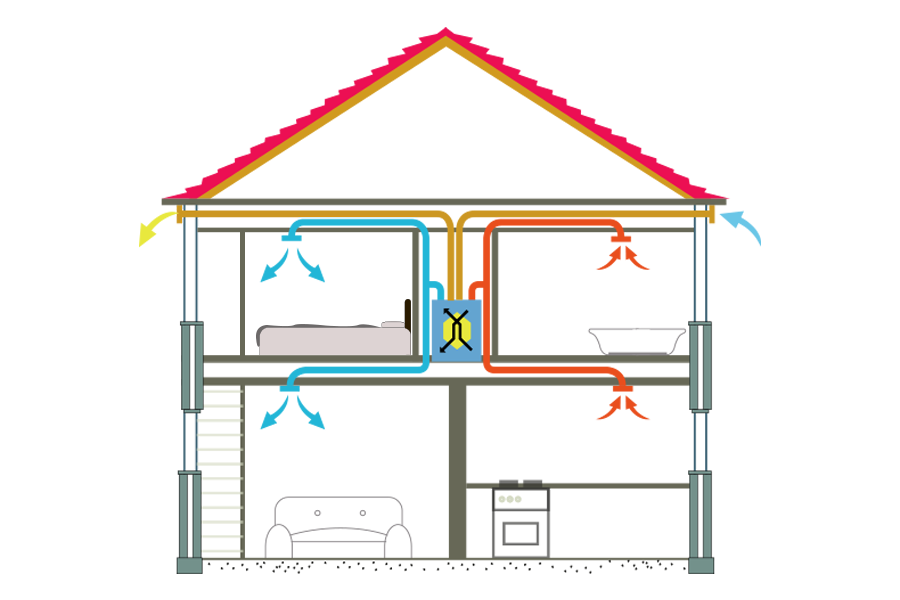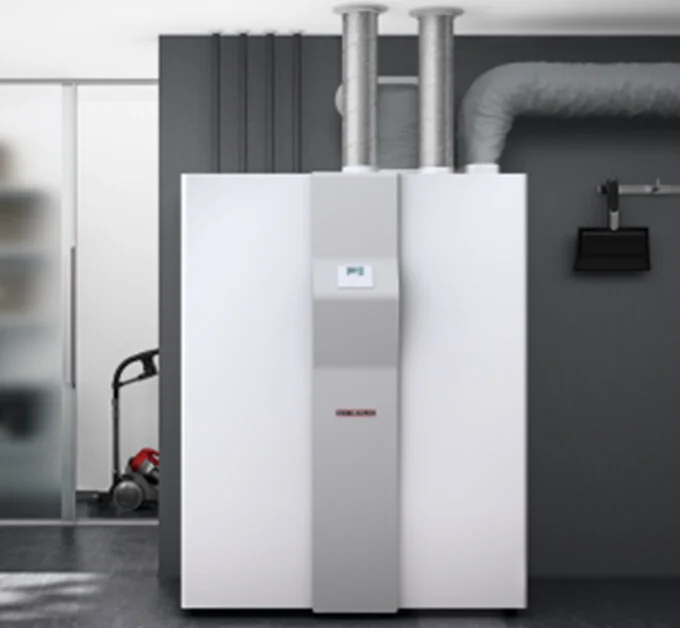What is a Mechanical Ventilation System?
Mechanical Ventilation systems are systems that provide better indoor air quality in homes and commercial buildings by extracting stale air or by supplying fresh air, some systems will extract and supply.
Without mechanical ventilation to provide fresh air, moisture, odors, and other pollutants can build up inside a home. Mechanical ventilation systems circulate fresh air using ducts and fans, rather than relying on airflow through small holes or cracks in a home’s walls, roof, or windows. Homeowners can breathe easier knowing their home has good ventilation.
There are two main aspects to MVHR – mechanical ventilation and heat recovery.
Mechanical ventilation is simply a duct coming into the building with a fan blowing fresh air in and a duct going out of the building with a fan blowing stale air out. Since the fans are powered and controlled, the ventilation is considered “mechanical” as opposed to a ventilation system with no power and no control such as ‘natural ventilation’. There is probably mechanical ventilation in some form in the building you are in right now – such as mechanical extract ventilation from a bathroom or kitchen.
Heat recovery is using a heat exchanger that takes the heat from warm air and gives it to cold air. The air inside a building is typically warm because it has been heated in some way so that the rooms are comfortable to inhabit. On the other hand, outside air is typically colder than indoor air for a large part of the year. Often, outdoor air is colder overnight all year round. This is the case even in climates we generally consider to be warm. By using a heat exchanger, fresh cold outside air can be warmed up to a comfortable temperature by using the heat of the warm stale indoor air as it is extracted.
The two air paths never come into contact with each other, so stale air is not mixed with fresh air. No contamination or pollution from the extract air can get into the fresh supply air. Only heat is transferred in the heat exchanger. (Moisture can also be transferred in an energy or enthalpy exchanger, but that isn’t the subject of this post.)
BENEFITS OF MECHANICAL VENTILATION
Better Indoor Air Quality. Indoor air can be many times more polluted than outdoor air. Ventilation systems can significantly improve a home’s air quality by removing allergens, pollutants, and moisture that can cause mould problems.
More Control. When homes rely on air flow through walls, roofs, and windows for ventilation, there is no control over the source or amount of air that comes into the house. In fact, air leaking into the house may come from undesirable areas such as the garage, attic, or crawl space. Mechanical ventilation systems, however, provide proper fresh air flow along with appropriate locations for intake and exhaust.
Improved Comfort. Mechanical ventilation systems allow a constant flow of outside air into the home and can also provide filtration, dehumidification, and conditioning of the incoming outside air.
Stiebel Central Ventilation: Fresh air everywhere
With central ventilation systems, there is a difference between extract air systems and supply/extract air systems. The simplest and most cost-effective system for central mechanical ventilation is an extract air system. Stale air is removed via ducts from areas such as the kitchen, bathroom and toilet. This causes negative pressure, which allows fresh air to be drawn through outlets outside, directly into areas such as the living room, playroom and bedrooms. The amount of air extracted is determined by the fan capacity. You're able to match you're the air flow rate to meet your needs with a simple switch. With a small heat pump, the extracted air can be used for heating hot water and central heating. Using this air at high temperatures as a heat source is incredibly efficient.
These ventilation ducts can be installed in walls, concrete or suspended ceilings, floor – or even in the open. This makes it a great option for renovations as well as new builds. The biggest advantage is the uniformed fresh air quality that is delivered across the entire building. The recovered energy can then be used to heat the air supply.
Unlike an extract air system, a supply/extract system draws the outdoor air from a central point before distributing via ducts to the supply air areas (living, loungerooms, bedrooms etc). Heat is recovered by a crossflow heat exchanger, which transfers up to 90% of the unused heat in the extract air into the supply air. The outdoor air is filtered to prevent any contamination of the ducts and system itself, and to protect allergy sufferers from dust and pollen. These systems ensure an excellent level of comfort across your whole home.



